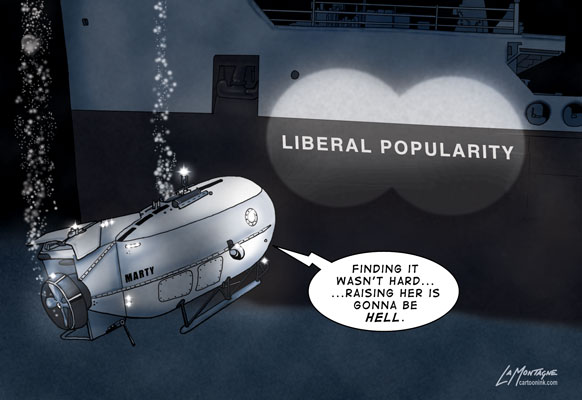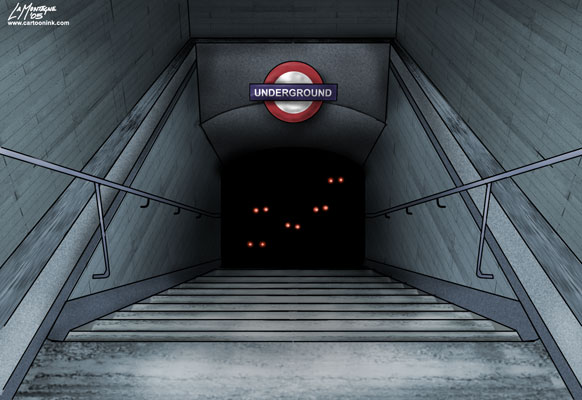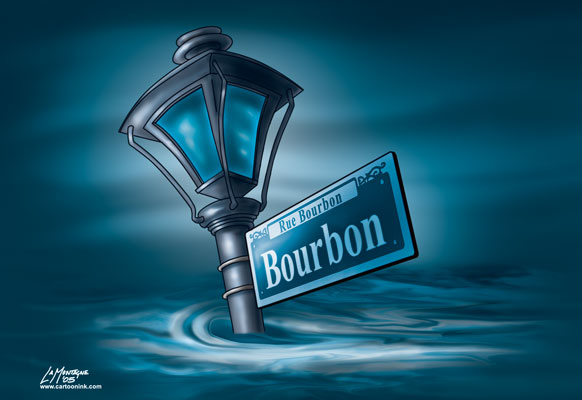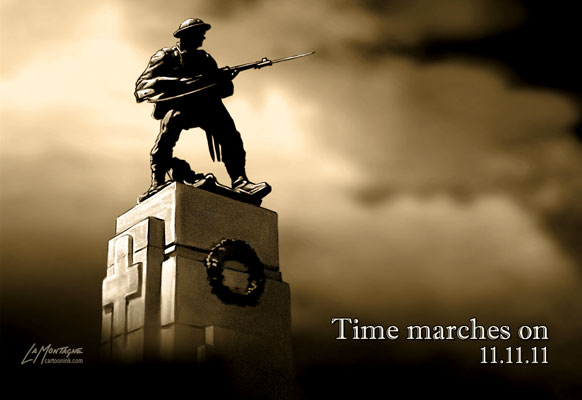Somebody asked me if I was going to be doing a cartoon about the 100th anniversary of the sinking of the Titanic.
It’s important to understand that the Titanic has long been one of the most overused clichés in editorial cartooning. Although I’ve never actually drawn the iconic ship, I’ve put a Prime Minister at the front of a ship referencing the ‘king of the world’ line. in 2004, I put a submersible at the bottom of the sea, with lights illuminating the words Liberal Popularity on the hull, talking about the difficulty of raising it. The ship obviously wasn’t the Titanic, but the reference could be interpreted that way, so I’m willing to concede that as ‘a Titanic cartoon.’
 There are many clichés in editorial cartooning, another being ‘the pearly gates’ cartoon. Somebody passes away and they’re almost always drawn exchanging words with St. Peter at the gates of heaven. While I have been guilty of picking the low hanging fruit from the idea tree, and using clichés from time to time, I’ve never actually depicted anyone at the pearly gates, and it’s doubtful I ever will.
There are many clichés in editorial cartooning, another being ‘the pearly gates’ cartoon. Somebody passes away and they’re almost always drawn exchanging words with St. Peter at the gates of heaven. While I have been guilty of picking the low hanging fruit from the idea tree, and using clichés from time to time, I’ve never actually depicted anyone at the pearly gates, and it’s doubtful I ever will.
I’m very fascinated by the story of the Titanic, and have been ever since I was a kid. While skiing in Kitzbuhel, Austria on a family vacation, (we lived in Germany for many years) my father, sister and I were stranded at the restaurant/chalet at the top when a wind storm rendered the cable car unsafe to take skiers down the mountain. I think I was 13 or 14. It became a party atmosphere and we ended up skiing down by torchlight later, but I remember sitting with some very kind University students from Southampton and being fascinated that they were from the same place that had launched the Titanic. Where the interest came from, I don’t know.
I’ve been to the Titanic exhibit twice, once in Las Vegas, and again when the traveling exhibit came to Calgary. I’ve seen a number of the movies more than once. I’m one of the few guys who will admit to seeing the movie in the theatre, not once, but three times. It just fascinated me to see it all unfold on the big screen, and I’ve always enjoyed James Cameron as a film maker. While I’m not obsessed with every detail of the story, I do know quite a bit of the trivia. I’ve got the DVR set to record all of the National Geographic specials this week, and watched James Cameron and crew dissect every last detail last night on how the ship ended up on the bottom looking the way it did. A forensic archeological deconstruction of the event, that even had him admitting he got a few details wrong in his larger than life movie.
 The London Bombings, July 2005
The London Bombings, July 2005
When bad things happen, it’s difficult to draw cartoons about it. Even worse is the pressure to get it out quickly, because after all, the goal is to be published in that empty space before a competitor can snag it with another cartoon, one they’re also feverishly drawing at the same time. I often feel like a vulture picking over the fresh carcasses of whatever unfortunate souls perished in the news event. Sounds pretty morbid, doesn’t it? That’s how it feels, too. How does one draw something appropriate, respectful, and sincere with very little time to mull it over? When the disaster or event is fresh and acute, that’s the time to get the cartoon done. I remember drawing a cartoon about the 2004 Tsunami in the Indian Ocean the day after Christmas, because it was big news.
 Hurricane Katrina. Found out later that Bourbon Street was largely spared.
Hurricane Katrina. Found out later that Bourbon Street was largely spared.
If it’s a big enough disaster, like Hurricane Katrina, there will be many cartoons in the days and weeks following, but that first cartoon is the most difficult. The other goal is to avoid the ‘yahtzee’ as it’s come to be known. That’s when two or more cartoonists come up with the same idea for the same situation at the same time. When the twin towers fell on 9/11, a number of cartoonists drew the same images. The towers as the number 11, with smoke coming from them was one. Another was tears in the eyes of the Statue of Liberty. Two of Quebec’s most celebrated cartoonists, Terry Mosher (Aislin) of The Gazette and Serge Chapleau of La Presse, drew the very same image.
I began my syndicated career at the end of September, 2001, so I never had to draw a cartoon about 9/11.
Situations like this, people are hurt, suffering and dying, and I have to draw a cartoon about it. It’s never supposed to be funny in a situation like that, but the goal is that it be moving, if only a little. If it’s a major news story, if an editorial is likely to be written, then an editorial cartoon needs to be drawn. It isn’t something I want to do most of the time, but it’s part of the gig, one I dislike very much. When somebody famous dies, I have to make the unenviable distinction between whether it’s newsworthy enough to warrant a cartoon. Was this person important enough that a newspaper will want to highlight it?
These are not my proudest moments.
So what about the Titanic? The disaster itself was one of the worst of its time. It shook the world and haunted the news pages for a long time. Countless books have been written on it, and historians still debate to this day, what happened on that night in April, 1912. But let’s be fair. It was 100 years ago. Had the ship made it to port in New York, everyone would still be deceased today. A tragedy, yes, but one that needs to be put into the proper historical perspective.
Each year, I have to do cartoons about Remembrance Day, to commemorate the Canadian men and women who’ve lost their lives in this century’s armed conflicts. It gets more and more difficult with each passing year. It will often be a respectful image, perhaps of a cenotaph or other memorial, an image of a poppy, and a quotation or a couple of lines. Over a decade of Remembrance Day cartoons and I’ve realized that I am unlikely to come up with anymore original ideas. It feels incredibly insincere, and definitely not the tribute owed to the sacrifice.
 Remembrance Day, 2011. The cenotaph in Victoria, BC.
Remembrance Day, 2011. The cenotaph in Victoria, BC.
If I have a hard time mustering the sincerity for something as important as that, due to the fact that it has become routine, anything I draw to commemorate the Titanic tragedy, will simply be paying lip service, and rehashing imagery that others have already thought of. If you don’t believe me, do an image search on Google. I still have a lot of interest in the story, the details fascinate me, but not because I feel anymore for those people than I do for those who perished on the Hindenburg or in the Civil War. It happened a century ago to people for whom I feel no connection.
The hubris of those involved in the Titanic’s conception, construction and operation caused the demise of the ship. There is a lesson we’re supposed to learn from the arrogance of believing we can ever conquer the forces of nature. Aside from a few changes to maritime law, those people died in vain, and therein lies the real tragedy of the event. We continue to choose to ignore the lessons of history.
I did wrestle with possible images on the subject. An image of the name of the ship in dark water with an appropriate memorial quote, something nautical perhaps. Maybe the flag of the White Star Line and some cautionary words about humility. Took me a couple of days to realize that everything I came up with made me feel like a hypocrite, trying to create an image to stir emotion about an event for which I feel none.
While I don’t always have the luxury of ignoring a news story, I think I’m just going to let this one go.

Great article. Well written, I appreciate the sincerity and down to earth-(ness).
heh…I must tell my husband that someone else in the world is as interested in the Titanic as me… He will be amazed, I’m sure:)
Nicely written, and I hope that some day we learn from our arrogance.